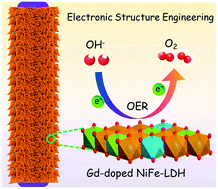Gd-induced electronic structure engineering of a NiFe-layered double hydroxide for efficient oxygen evolution†
Abstract
Rare earth (RE) elements have drawn increased attention recently as an effective promoter in electrocatalysis because of their partially filled 4f orbitals. Herein, a new type of RE hybrid electrocatalyst, consisting of a gadolinium-doped hierarchal NiFe-layered double hydroxide in situ grown on carbon cloth (Gd-NiFe-LDH@CC), is designed and developed via a facile one-step hydrothermal approach. The Gd doping regulates the electronic structure of NiFe-LDH and increases the number of oxygen vacancies, thus tuning the adsorption energies of oxygen intermediate species (e.g. HOO*). With the presence of Gd species, Gd-NiFe-LDH@CC exhibits superior electrocatalytic activity for the OER in an alkaline medium, which requires an overpotential of only 210 mV to afford 10 mA cm−2 current density, better than that of NiFe-LDH@CC (250 mV) and commercial RuO2 (298 mV). The robust electrocatalytic stability and satisfactory selectivity (nearly 100% Faraday efficiency) of Gd-NiFe-LDH@CC for the OER are also demonstrated. We ascribe such outstanding OER performance of Gd-NiFe-LDH@CC to the optimized electronic structure, rich oxygen vacancies and hierarchal porous morphology. Theoretical calculation further demonstrates that the electronic disturbance caused by Gd doping enhances the activity of Ni sites, resulting in stronger binding strength of HOO* at the Ni sites during the OER.

- This article is part of the themed collection: 2021 Journal of Materials Chemistry A most popular articles


 Please wait while we load your content...
Please wait while we load your content...